Vietnam has a tropical and subtropical climate that makes it ideal for growing a wide variety of tropical and subtropical fruits. These Vietnamese fruits are showcasing the country’s rich agricultural diversity.
1. Mangosteen-Queen of Vietnamese fruits
Known as the “queen of Vietnamese fruits,” it has a sweet and tangy white pulp inside a thick purple rind. Mangosteen is a seasonal fruit, typically available from May to September. Mangosteen is primarily grown in the Mekong Delta region, especially in provinces such as Tien Giang, Ben Tre, and Long An.
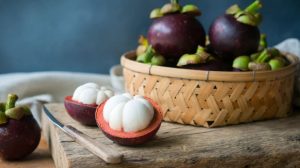
How to Eat: Cut open the thick purple rind to access the white, segmented flesh inside. It’s typically eaten fresh, often as a refreshing snack or dessert.
2. Durian-King of Vietnamese fruits
Known as the “king of Vietnamese fruits,” a polarizing fruit—loved by some for its rich flavor and creamy texture, yet avoided by others due to its strong aroma. High in calories, fiber, vitamin C, potassium, and healthy fats. It’s rich in antioxidants and has anti-inflammatory properties. durian is mainly grown in the Mekong Delta region, with key provinces including Tien Giang, Ben Tre, and Long An.
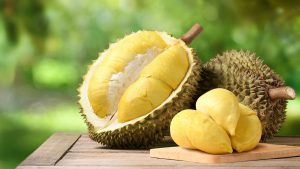
How to Eat: Often eaten fresh by scooping out the creamy flesh. Also used in desserts, ice creams, or smoothies. Due to its strong smell, it’s sometimes banned in public places.
3. Mango
Mangoes are a versatile fruit, enjoyed worldwide for their rich flavor and numerous health benefits. Mangoes are primarily grown in the Mekong Delta region, with notable provinces such as Tien Giang, Ben Tre, and Long An. High in vitamin C, vitamin A, folate, and fiber. Mangos also contain several polyphenols with antioxidant properties.
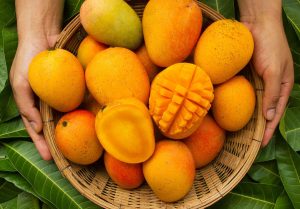
How to Eat: Slice the mango and scoop out the flesh. It’s enjoyed fresh, in smoothies, desserts, or savory dishes like salads and salsas.
4. Rambutan-One of the most special Vietnamese fruits
Rambutan is a beloved tropical fruit, known for its striking appearance and sweet, juicy flesh. Rich in vitamin C, copper, and fiber. It also contains small amounts of iron and antioxidants. Grown in the Mekong Delta region, with key provinces including Long An, Tien Giang, and Ben Tre.
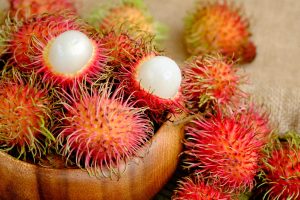
How to Eat: Peel off the hairy skin to reveal the translucent flesh. Eat fresh, but be careful of the seed inside. It’s also used in fruit salads and desserts.
5. Lychee
A sweet, aromatic fruit with a rough red skin and translucent white flesh. Lychee is primarily grown in the northern provinces, with Hai Duong and Bac Giang. High in vitamin C, potassium, and antioxidants like flavonoids. It’s also a good source of dietary fiber.
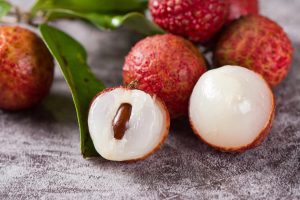
How to Eat: Peel the rough outer skin and remove the seed. The flesh is sweet and juicy, enjoyed fresh or used in desserts and drinks.
6. Jackfruit
A large fruit with sweet, fragrant yellow pods inside, used in both sweet and savory dishes. Rich in vitamin C, fiber, potassium, and antioxidants like carotenoids. It’s also a good source of energy and has a low glycemic index.In Vietnam, jackfruit is mainly grown in provinces such as Binh Duong, Long An, and Tay Ninh.
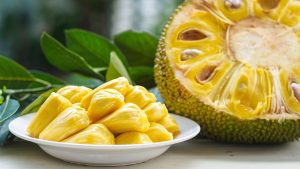
How to Eat: The ripe yellow pods inside the spiky outer shell can be eaten fresh, used in desserts, or cooked in savory dishes like curries.
7. Dragonfruit
Comes in both red and white flesh varieties, with a mildly sweet taste. grown in the Mekong Delta region, with key provinces including Binh Thuan and Long An. Low in calories and rich in fiber, vitamin C, and antioxidants like betalains, which help reduce inflammation.
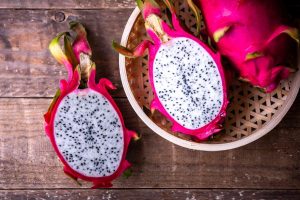
How to Eat: Cut in half and scoop out the flesh with a spoon. It can be eaten fresh, added to fruit salads, or blended into smoothies.
8. Papaya
Available in green and ripe varieties, used in both savory dishes and as a sweet fruit. High in vitamin C, vitamin A, folate, and fiber. Papaya contains an enzyme called papain, which aids digestion.
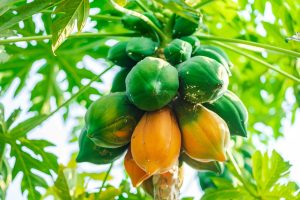
How to Eat: Cut the papaya in half, scoop out the seeds, and eat the orange flesh. It’s delicious fresh, in salads, or blended into smoothies.
9. Starfruit
The Starry Tropical Fruit, a juicy fruit with a star-shaped cross-section, mildly sweet and tangy. Available year-round, with peak season from August to October. It is rich in vitamin C, antioxidants, and fiber, while being low in calories. It supports immune health, digestion, and heart health.
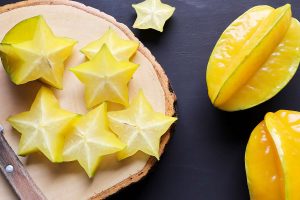
How to eat: Starfruit can be enjoyed fresh, in salads, smoothies, juices, and desserts, or used in cooking. Its vibrant appearance and refreshing taste make it a versatile ingredient in a variety of dishes.
10. Longan
Longan is one of the Vietnamese fruits known for its sweet, juicy flesh and distinctive flavor. It is rich in vitamin C, B vitamins, antioxidants, and essential minerals, supporting immune health, digestion, and energy metabolism.
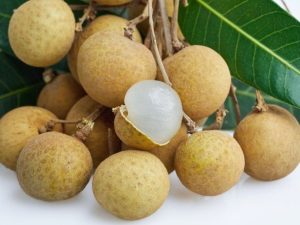
How to Eat: Peel the thin brown skin and enjoy the translucent flesh. It’s commonly eaten fresh or used in desserts and soups.
11. Star apple
Star apple, or cainito, offers a sweet and creamy flavor reminiscent of apple and pear with hints of vanilla. Its juicy, gel-like texture is smooth and tender, providing a refreshing and tropical eating experience. Rich in vitamin C, calcium, and dietary fiber. It also provides a good amount of antioxidants.
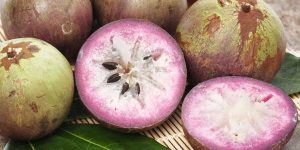
How to Eat: Cut open and scoop out the milky, star-shaped flesh. Best eaten fresh as a sweet, cooling treat.
12. Sapodilla
Sapodilla offers a rich, sweet flavor with malty and caramel-like notes, reminiscent of pear and brown sugar with a hint of banana. Its smooth, slightly grainy texture and tropical taste. High in dietary fiber, vitamin C, and natural sugars. It’s also a good source of antioxidants like tannins.
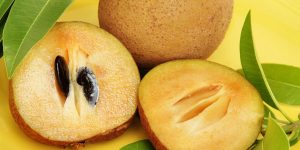
How to Eat: Peel the skin and eat the brown, sweet flesh. It’s often eaten fresh or used in milkshakes and desserts.
Vietnamese fruits are diverse and flavorful, from the sweet dragon fruit and creamy mango to the tangy starfruit and fragrant lychee. Each fruit offers unique tastes and nutritional benefits, enhancing tropical cuisine.
![]() Visa FOPA Company
Visa FOPA Company
📞+84 906 044 975 (Mr. Do)


